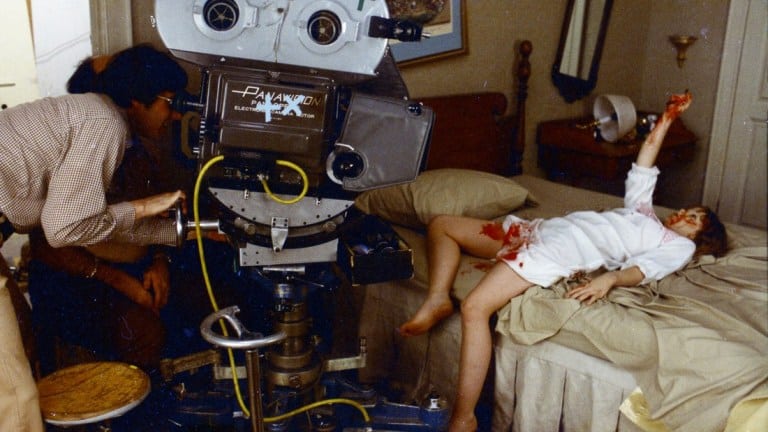★★★★ out of ★★★★★
Directed by Alexandre Philippe (78/52)
There exists that great space in documentaries that take place decades after the event occurred. It’s this beautiful melange of revisionist history, lucid thoughts, purposeful sleepwalking, and repressed memories. All answers are correct and infallible when the documentary is filtered through the iconic lens of a single and thoughtful directorial darling. THE William Friedkin is the ultimate bridge between Hollywood’s glorious beginnings and the revolutionary young guns of the 1970s. It should come as no surprise the Friedkin has some rather insightful things to say about one of the greatest films of the 1970s, possibly the greatest horror film of all time, and in some camps, THE greatest film ever put down on celluloid — the Exorcist.
From the first line in the film Friedkin hilariously declares that “the word possesses possesses more S’s than any word possesses.” Following this intentionally funny (or not) opening, Friedkin moves in to a fascinating discussion of the role of Fate vs. Faith in cinema and day-to-day choices. Claiming that the 1955 Danish film Ordet was his singular influence in making the Exorcist, he goes on to discuss a myriad of foundational influences that informed his cinematic language. From Citizen Kane to the Dutch Masters, and from Lalo Schifrin to his abiding friendship with the Exorcist author William Peter Blatty, Friedkin leaves no stone unturned.
He seemlessly wanders from the organic way that the film was conceived by noting that there were “…forces beyond me that brought things to that movie like offerings”, to a discussion of the cliched nature of foreshadowing and clumsy metaphors. Interestingly, a good piece of the film discusses the opening scene in the Exorcist that actually takes place in Northern Iraq where Friedkin was lucky enough (or was pre-ordained) to meet up with a German archeology expedition in the middle of a real dig. He discusses the beauty of the area, the shots, the sounds, and the importance of making sure this titular moment was translated from the book to film. Allegedly the importance of the discovery of the demonic Pazuzu talisman escaped everyone from Lalo Schifrin to Willam Peter Blatty. Even cinematic maestro Bernard Herrmann thought the whole point of the opening scene was a hot pile of garbage.
Friedkin moves between the concept of fate and deliberate forethought throughout the film and gives the viewer the impression that some of the Exorcist was dumb luck, while the large majority of it — lighting, music, sound, and casting — was hyper-deliberate and unwavering in its mission. The one thing that Friedkin makes abundantly clear is that he wanted to make sure that possession had time to linger and as he notes “it takes a while to get to the possession, as well it should” and he further notes that the film, much like music, should build layer on layer on layer.
Beyond weaving through his classic influences and a heady discussion of destiny and the nature of man, Friedkin drops a number of fascinating tidbits that even the most grizzled horror fan may not have been aware of, including:
- Stacy Keach was originally hired to play the role of Father Karras. No-name playwright Jason Miller convinced Friedkin he needed to be Father Karras, but because Keach was already under contract, the studio had to pay Keach his entire salary for doing no work.
- In addition to Keach and Miller, William Peter Blatty also threw his name in the hat to play Karras. And allegedly offered to take no money for the chance to play Karras.
- Stanley Kubrick and Mike Nichols were offered the directorial role, but passed.
- The demon’s voice was concocted by film legend Mercedes McCambridge. She told Friedkin that she, and only she, could manufacture the demon sounds through a steady diet of alcohol, raw eggs, cigarettes, and mild torture. Even though she was a reformed alcoholic she agreed jump off the wagon and headlong in to demonic voice work.
- Friedkin asked his good friend, conductor Lalo Schifrin, to score the film. After Friedkin told him he was rather displeased with his work, the two never spoke again.
- The faint and chilling sounds noises at the beginning of the film are the subtle result of a finger running across the top of a wine glass.
- Friedkin admits to firing off weapons and punching his actors to purposefully startle them before shooting scenes.
All these things and more are discussed and ruminated on by a thoughtful and ingenious film auteur. Seemingly nothing was off topic, nothing was scripted, and nearly every possible aspect of the Exorcist was thoroughly analyzed. Well, almost everything. As the aforementioned grizzled horror fan, it sure would have been nice to know what Friedkin thought of the Exorcist II, and the Exorcist III, and whether he still talks to Linda Blair, and how they did the stairwell crawling scene, and, and…there are so many questions that could have been asked. But as Friedkin himself notes when asked about the true demonic possession, he curtly responds “Do I have any idea if there’s such a thing as demonic possession? No I don’t. We don’t know anything.”
Leap of Faith is probably Rated R and will hopefully becoming to a video store near you.


